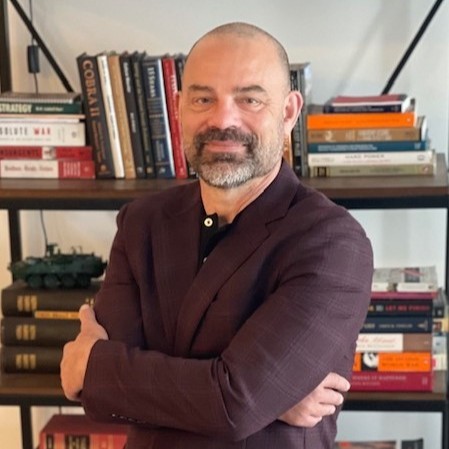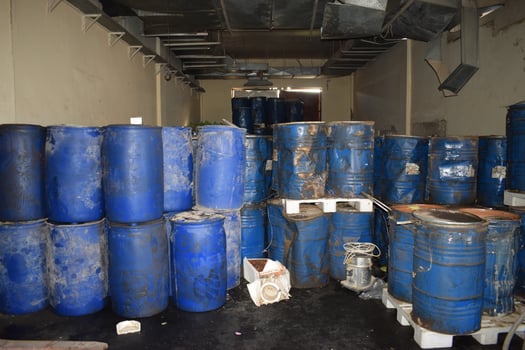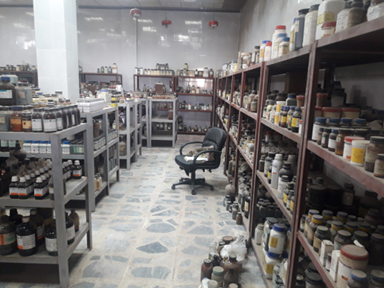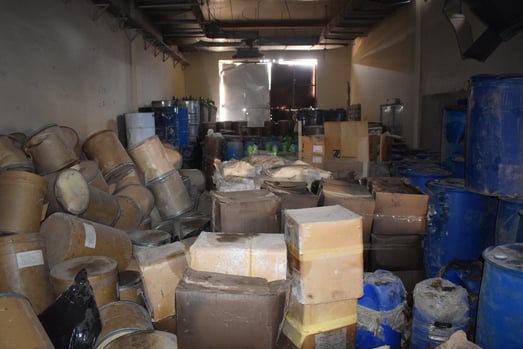CBNW Magazine - Weaponized Pharmaceutical Compounds are a Clear and Present Danger

January 8, 2024 - This article first appeared on www.nct-cbnw.com
 Throughout history, military commanders have used fatal or toxic chemical agents as a part of their battlefield strategies. The First World War is known for the widespread use of mustard gas, which caused devastating and fatal effects. However, in today’s combat arena, the threats posed by chemical warfare have expanded to include the application of legitimate pharmaceutical compounds as weapons.
Throughout history, military commanders have used fatal or toxic chemical agents as a part of their battlefield strategies. The First World War is known for the widespread use of mustard gas, which caused devastating and fatal effects. However, in today’s combat arena, the threats posed by chemical warfare have expanded to include the application of legitimate pharmaceutical compounds as weapons.
The link between agents of war and medicine is almost as old as warfare itself, with compounds designed as weapons manipulated into prescription drugs while legitimate treatments are adapted for war. For example, mustard gas was designed to kill and maim people when developed in the early 1800s, but in the 1940s it led to the development of cancer treatments (since discontinued).
Today’s fields of combat, from open fields to the confined spaces of urban warfare, also recognize the danger that chemical warfare agents and toxic industrial chemicals pose to combatants and surrounding civilians, and military strategists prepare accordingly. However, the threat of legitimate pharmaceutical agents is an area where military and civilian authorities lack sufficient preparation.
These pharmaceutical agents are not always deployed with the intent to kill the enemy but to incapacitate them. For those with pre-existing conditions, which can be up to 50% of the soldiers in the field, these agents can be fatal, further weakening the defensive or offensive capabilities of the targeted force.
Why use Pharmaceutical Compounds?
With so many dangerous chemicals available, one may ask why pharmaceuticals would be of interest in combat theaters. The answer is their availability and ease of use.
Chemical warfare agents have been strictly controlled since the Great War. Most nations - except Egypt, North Korea, and South Sudan - have signed the Chemical Weapons Convention (CWC) since its inception in 1997 onwards, which prohibits the use of chemical weapons or their large-scale development, production, stockpiling, or transfer (including precursor chemicals), except for limited research.
While pharmaceutical agents were only acknowledged as an emerging threat five years ago, their use in specific operations goes back much further. On October 23, 2002, Chechen terrorists seized the Moscow Dubrovka Theater, capturing 912 hostages. Due to the complexity of getting to the well-defended main hall, the Russians pumped pharmaceutical agents into the building to incapacitate the terrorists.
Unfortunately, while the pharmaceutical compounds left the terrorists unconscious, after which the Russian strike teams killed them, they also impacted the hostages and the operation left 129 people dead at the scene or shortly after, plus an additional 33 terrorists. While the Russians have not verified the specific pharmaceutical gas used, it is believed that they deployed fentanyl derivatives. In this instance, pharmaceuticals were used by law enforcement, but their effectiveness was demonstrated, specifically in closed areas.
 Easy and Safe Access
Easy and Safe Access
When it comes to legitimate pharmaceutical compounds, however, access to these chemicals and their precursors is simple, as is their storage and deployment. Deadly agents can be bought relatively easily in almost any pharmacy – although the dosages are limited for safety purposes. The problem is that the laws governing the availability and accessibility of these agents depend on the country in which they are sold.
Every hospital, for example, has a pharmacy with a section including unesthetic chemicals designed to be safely used in surgery by highly trained professionals. The volume of chemicals and the ease or difficulty with which somebody can access them depends on the local regulatory environment and the hospital’s adherence to safety standards.
Pharmaceutical agents and their precursor drugs are also easier to import and transport for bad actors, making them a tempting target for those looking to cause havoc and for the nation-states supporting them in covert operations to weaken their enemies.
Defending against these compounds is now a critical aspect of combat operations, both offensive and defensive. However, this is a complex task. Military personnel are equipped with personal protective equipment (PPE) to cater for possible chemical attacks, but they may not serve their purpose effectively when it comes to modern pharmaceutical compounds.
Forcing PPE Usage on the Battlefield
Astute commanders on the battlefield are cautious about the possibility of their adversaries using pharmaceutical compounds against them. They know that the type of pharmaceutical material used can compel them to order their troops to wear PPE. While PPE can ensure the soldiers’ protection, it can also hinder their progress due to several factors. These include:
- PPE efficacy not guaranteed: PPE kits, while undeniably necessary, are not guaranteed 100% effective against pharmaceutical weapons as the equipment is primarily designed to counter organophosphate compounds. This means they may miss some pharmaceutical agents that do not contain these molecules. The result is that a respiratory filter, for example, may not filter out these chemicals while effectively protecting against other toxic substances.
- Physiological restrictions: Combat requires soldiers to be able to move and react quickly to the changing circumstances on the field of battle. Wearing PPE can negatively affect combatants’ performance, as wearing protective masks, rubber gloves, and other coverings protects people from dangerous chemicals but can hamper free and easy movement.
Heat fatigue, coupled with dehydration, is also a risk from being covered with rubber clothing, as soldiers are not able to take off their masks to rehydrate.
Sight restrictions from headgear and goggles, especially when it comes to peripheral vision, can diminish the soldier’s situational awareness. The additional layers of clothing also restrict movement and cause slower reactions while negatively impacting aim-fire capacity.
- Communication degradation: A more critical hindrance can be the degradation of communications. Reporting on situations and hearing orders from leaders during battle is challenging enough, but with PPE, sounds are muffled and the longer the combatants are engaged, the greater the opportunity for miscommunication.
- Psychological challenges: PPE also creates a psychological challenge for soldiers. The troops know there is some poison in the air or on the ground, an unseen, potentially deadly agent against which they have no defenses. They must hope their PPE prevents harm and permits physical activity with as little hindrance as possible. While all military engagement is stressful, some soldiers may find encounters involving chemical agents to be more frightening as there is no visible enemy. They are dependent on their PPE, and they know this.
As noted, despite very advanced technology, the ability to accurately detect chemical agents in a potential battle can also be hampered by the lack of organophosphates in pharmaceutical agents. Additionally, it is not only about organophosphates but also the sample size, usually measured in parts per million (ppm). Pharmaceutical agents require a lower ppm than toxic chemicals to incapacitate the enemy. This may also lead to a false negative if the devices used to check for chemicals cannot measure lower ppm or are not configured correctly.
Presumptive identification saves lives
This is not to say that PPE should not be used. On the contrary, PPE is a critical component of any military expedition, as well as operations by first responders in civilian settings, from police officers to firefighters and paramedics. The key is knowing when to use them and being confident they will be effective against whatever agent is deployed. This requires the correct instruments to perform presumptive analysis and quickly identify chemicals in the surroundings.
With effective analytical capabilities, presumptive identification of agents takes a minute. It gives commanders the confidence to strategize and engage the enemy with over 90% confidence that they will not stumble into a chemical trap. While they can never be 100% sure, a scientifically determined 90% is better than hoping for the best.
In the case of a pharmaceutical agent attack, either before or after the engagement starts, presumptive analysis once again permits accurate identification of chemicals to empower medical staff with the knowledge of what medication and treatment they need to prepare for. Without this identification, medics play a guessing game based on their experience until they can perform an accurate analysis, usually only after the first people have been lost.
Theaters of Risk
The battlefield for pharmaceutical agents is broad and dangerous. Terrorists and other bad actors with hostile agendas can take advantage of the ease of accessibility of these chemicals and deploy them in large or small theaters of operation with devastating effects.
Deploying pharmaceutical agents in contained areas such as planes, malls, cinemas, etc. will almost always guarantee casualties and mass panic. In short, it is the perfect weapon for urban warfare. Attacks can be fast and brutal, with a high body count without requiring metric tons of the chemical agent or missiles loaded with the substance.
It is essential to consider the potential threat that pharmaceutical chemical agents pose in the future. With the help of artificial intelligence (AI), it will become increasingly easy for bad actors to analyze the structure of an existing chemical and create a derivative with customized effects. These customizations could alter the speed at which the chemical works, how it incapacitates individuals and even the delivery method.
Irrespective of where the attack takes place or its scope, more than simply having the technology to detect dangerous chemicals is required. Individuals must receive proper and comprehensive training to conduct presumptive analysis and be situationally aware to identify potential signs of pharmaceutical agents in their surroundings. This is important so that they can initiate an identification process and warn their teams. Apart from that, it is a matter of planning and thoroughly rehearsing response tactics when positive agent identification occurs.
Pharmaceutical agents were not seen as high-risk threats in the past. Still, the utility of these chemicals has resulted in the risk migrating from an emerging risk to a real danger that military commanders and first responders must cater to in their planning and preparation. The most important part of this preparation is accurately identifying threats in under 60 seconds and initiating the predetermined precautionary measures with minimal delay.
Dr. Jeff Brodeur has experience developing CBRN strategy, plans, and training programs at all echelons of the U.S. Department of Defense from a strategic, operational, and tactical perspective. He was formally trained at the U.S. Army Command and General Staff College and the U.S. Army War College, and his past performance includes senior battle staff at the Army Division (2-star), Army Service Component (3-star), and Geographic Combatant Command (4-star). Jeff's last military duty assignment was the Assistant Commandant for the U.S. Army Chemical-Biological-Radiological-Nuclear schoolhouse and Regimental headquarters where he expertly managed the professional military education curriculum, training, and administrative management of an annual student load of approximately 8,000. Jeff has a Doctorate degree from Colorado Technical University and is an internationally recognized CBRN expert with conference keynote speaker and panel member experience in USA, Canada, Iraq, Brazil, and Sweden.
